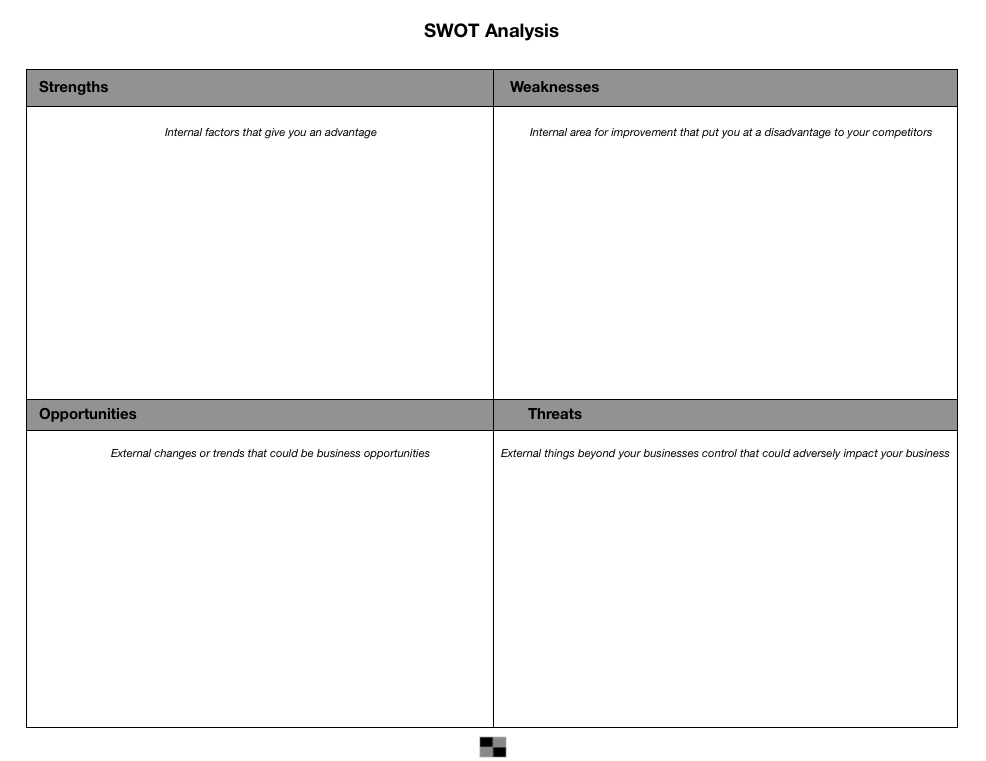
A SWOT analysis is a simple yet powerful tool that will help you understand four important aspects pertaining to your organization.
SWOT stands for:
- Strengths
- Weaknesses
- Opportunities
- Threats
This analysis can help you determine where the organization is performing particularly well and where it’s not. It also helps to identify external factors such as new avenues your company can pursue and what types of factors can harm your organization.
Strengths and weaknesses are internal to your organization which are more under your control and thus easier to address.
Opportunities and threats are external factors. In some cases, you will have limited to no control over them.
Knowing is half the battle when you are planning.
This is why we do a SWOT. We want to uncover the good and the bad so we can plan for it.
Strengths
Strengths are the things that your organization does well. It’s what gives you an advantage over your competitors. It could be a product, a CEO, a designer, or even a culture.
It’s easy to see strengths in sports teams so I’m going to use the New England Patriots as an example.
Love them or hate them, there is little doubt that the Patriots have consistently been one of the top organizations in the NFL since 2000 in which they have won 74% of their regular-season games and 75% of their post-season games. They have also won six Super Bowls.
There are many things that obviously gone right over the last 20 years but I see three strengths: the front office, the coaching, and the quarterback.
Robert Kraft bought the team in 1994. In the previous 34 years, the team made the playoffs only six times while going to the Super Bowl once. Since he bought the team 25 years ago, they have made 19 playoff appearances (soon to be 20). It starts at the top and he has been able to build a team that is the envy of the league (and much hated by anybody who isn’t a Patriots fan).
Bill Belichick is the head coach and the and has control over football operations. This means he not only coaches the team but determines everything from the staff to the players on the team. Normally over a period of success teams will start to become a victim of their own success because coaches leave and they have lower draft picks. This hasn’t been a major issue under Belichick’s reign and the results speak volumes. His teams have won a minimum of 10 games a year since 2003. They have won their division in all but three years of his tenure including the last ten in a row. As if that’s not enough, they have been to 13 AFC Championship games and to nine Super Bowls. And of course as previously mentioned, he’s won six Super Bowls. Like him or hate him, the man gets results.
Tom Brady is a 14x Pro Bowl quarterback who joined the Patriots at the same time Belichick became its coach. He’s won the league MVP three times and has won the Super Bowl MVP four times. At 42, he is still one of the best quarterbacks in the league and owns a bevy of NFL records including the most games won by a quarterback and the oldest quarterback to win an MVP to name just a couple. When Tom Brady is on the field the Patriots always have a chance to win.
These are three distinct strengths that have made the New England Patriots arguably the top team in the NFL since 2002.
Weaknesses
Weaknesses are those things that prevent the organization from performing at its optimum level. These are the things that need to be improved. The consequences of not improving weaknesses could be fatal in the long run. Let’s look at a business example this time.
Apple had a string of failures that nearly destroyed the company in the 1990s. They had multiple weaknesses but four big ones were: the operating system, the cost of hardware, the perception of the hardware, and they were a vertical company.
The operating system was badly outdated and was a generation behind Microsoft’s Windows PC platform. It was also under assault by operating systems made by other companies as well, some developed specifically for the Apple Macintosh such as BeOS.
The hardware was perceived as being too expensive when compared to its PC competitors. To make matters worse, it was also perceived as average at best, some saying it was just a toy compared to its PC cousins.
Apple had always operated as a vertical company, it built the operating system and the hardware. In the 1990s horizontal companies ruled the day in the technology world.
Gateway, Dell (and many others) made the boxes, Intel built the silicon inside, and Microsoft provided the operating system. These were four of the largest tech companies in the world at that time. They focused on specific functions that made PCs cheaper and faster than Apple’s Macs which were just an expensive also-ran (ironically being a vertical company became a strength for Apple when Steve Jobs returned to the company).
These were just four of Apple’s weaknesses but there are plenty of other examples such as too much debt (an issue for AT&T at the moment), high turnover, or a poorly run supply chain.
Opportunities
Opportunities are where a set of circumstances could be favorable for the organization. They are where an organization can do business that has a positive impact on the company financial or otherwise.
While Apple was the first company to ship a computer with a graphic user interface (GUI) it was proprietary and only worked on its Macintosh. This left the rest of the personal computing world without a comparable operating system.
Bill Gates, the founder of Microsoft, suggested to Apple that it license the MacOS operating system but Apple declined. This lead to an opportunity for Gates and his company.
Microsoft stepped into the void and built Windows which became the most used operating system in the world. It also propelled Microsoft into one of the largest and most powerful companies in the world.
Opportunities only become opportunities when we recognize them as such. It could be a partnership with the community that provides your company with some good public relations.
It could also be an idea or a product or a sector that is underdeveloped.
Threats
Threats are external to your organization and can cause harm. In some situations, they may be completely out of your control such as a recession, a natural disaster, or a change to an algorithm.
The Great Recession that started in 2008 wiped out multiple banking institutions in the United States. It also pushed General Motors and Chrysler into bankruptcy.
The music industry failed to see the threat of giving MTV music videos for free in the early 80s. By the time they figured it out MTV was a cultural force and a multi-billion dollar business. While the music labels figured out the mistake it was too late. They missed out on tens of millions of dollars in licensing revenue.
The music industry then made another mistake in the mid-90s by missing the threat the internet could be to its distribution model. Napster turned the industry on its head as it made it easy for people to share music over the internet for free.
While some companies might and industries survived threats that they never saw coming, many don’t.
You certainly can’t plan for every possible scenario that might happen but it’s good to sit down and assess current and potential threats.
By acknowledging threats you can make plans on how to deal with them.
Ignoring threats means you won’t have a plan and will be reactive to any problems when they arise. When this happens you may not be in a position to survive the threat.
The SWOT Analysis
A SWOT analysis isn’t a hard process. It just requires taking the time to do it.
Every SWOT Analysis I’ve done has used a template like the one below.

You don’t have to use this template but it does make it easy to see everything in one place.
There is no rule on how many items you have to put in each section. You could have ten strengths or three. It doesn’t matter. The only important thing is that you identify each one.
I like doing a SWOT as part of the planning phase. It’s something we review every year so the SWOT is also reviewed and updated with your yearly plans.
If you’re in a fast-moving industry, you might want to review it more often such as twice a year.
Another benefit of this process is it can help you identify areas where you are different than competitors which also important to know for your marketing communication efforts.
Final Thoughts
A SWOT analysis is a great tool to help you identify where your company stands. Acknowledging this will help with planning and also the general welfare of your company.
The comments are yours.
- The Importance of Creating a Connection With Your Marketing - June 6, 2024
- Reach vs Visibility: Which is Right for Your Marketing? - February 13, 2024
- Focus Your Marketing Efforts By Saying “No” - December 13, 2023
